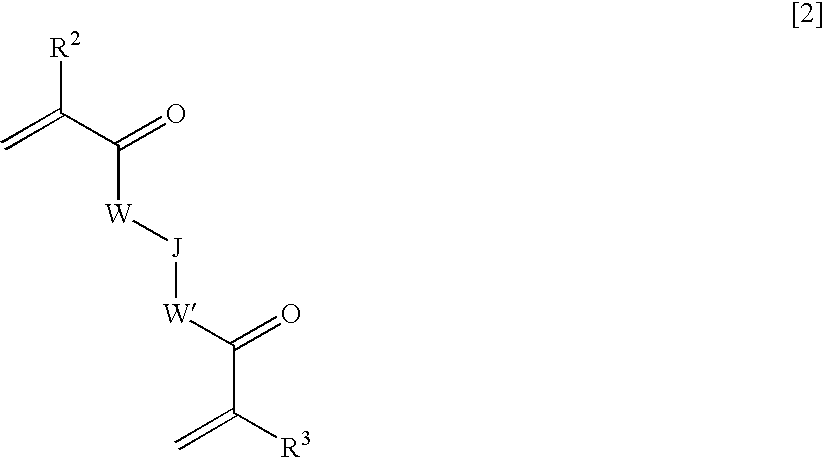Ophthalmic and otorhinolaryngological device materials containing an alkyl ethoxylate
a technology of ophthalmic and otorhinolaryngological devices, which is applied in the field of improved ophthalmic and otorhinolaryngological device materials, can solve the problems of less desirable than other materials, prone to explosive unfolding, and relatively low refractive index of hydrogel materials, and achieve the effect of reducing or eliminating temperature-induced glistening formation of hydrophobic acrylic copolymers
- Summary
- Abstract
- Description
- Claims
- Application Information
AI Technical Summary
Benefits of technology
Problems solved by technology
Method used
Image
Examples
example 1
[0083]Terg15S30-MA. 50.1 g (34.0 mmol based on OH#=38.0 mg KOH / g) of Tergitol 15-S-30 surfactant (Dow / Union Carbide), 15.7 g (102 mmol) methacrylic anhydride (Aldrich, 94%), and 20 mg MEHQ (Sigma-Aldrich) were dissolved in 120 g anhydrous pyridine (Burdick & Jackson) in a 500 ml round bottom flask equipped with magnetic stirrer and nitrogen inlet. The reaction mixture was heated at 50° C. for 20 hours, poured into 3000 ml diethyl ether, and subsequently cooled to −20° C. The solvent was decanted and the solid was recovered by centrifugation. The solid was redissolved in ether and the product was recovered as previously described to give 43.8 g (80%) of a white waxy solid.
example 2
[0084]Terg15S40-MA. 105.0 g (54.7 mmol based on OH#=29.2 mg KOH / g) of Tergitol 15-S-40 (Dow / Union Carbide) was dissolved in 300 ml anhydrous pyridine. 20 mg MEHQ and 50 mg dibutyltin dilaurate (Aldrich, Milwaukee, Wis.) were added followed by 17.6 g methacrylic anhydride (Alfa Aesar, 94%). The reaction mixture was heated at 60° C. for 15 hours and the solid isolated by precipitation in diethyl ether 3 times as described in Ex. 1 to give 90 g (82 %).
example 3
[0085]The reaction components listed in Tables 1-4, except for AIBN, were mixed together with stirring or shaking for at least 30 minutes at 23° C., until all components were dissolved. The AIBN was subsequently added and the reaction mixture was stirred for an additional 5 minutes or longer, until the initiator was dissolved. The reactive components are reported in weight %.
[0086]The reactive components were purged for approximately 15 minutes using N2 and placed inside a low humidity N2 purged glove box.
[0087]The reactive components were syringed or pipetted onto clean polypropylene mold halves containing 1×10×20 mm rectangular wells and covered with the complementary flat polypropylene mold halves. The mold halves were compressed using binder clips and the mixtures were heat ramped from ambient temperature to 70° C. in 15 minutes, and then cured at 70° C. for 1 hour and 110° C. for 2 hours using a Yamato DKN400 constant temperature oven. The molds were allowed to co...
PUM
| Property | Measurement | Unit |
|---|---|---|
| refractive index | aaaaa | aaaaa |
| glass transition temperature | aaaaa | aaaaa |
| Tg | aaaaa | aaaaa |
Abstract
Description
Claims
Application Information
 Login to View More
Login to View More - R&D
- Intellectual Property
- Life Sciences
- Materials
- Tech Scout
- Unparalleled Data Quality
- Higher Quality Content
- 60% Fewer Hallucinations
Browse by: Latest US Patents, China's latest patents, Technical Efficacy Thesaurus, Application Domain, Technology Topic, Popular Technical Reports.
© 2025 PatSnap. All rights reserved.Legal|Privacy policy|Modern Slavery Act Transparency Statement|Sitemap|About US| Contact US: help@patsnap.com



